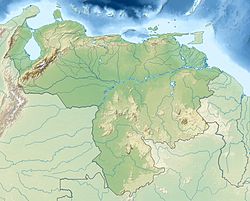geo.wikisort.org - Mountains
Cerro Duida, named Yennamadi by the ye'kwana,[2] is a very large tepui in Amazonas state, Venezuela.[1] It has an uneven and heavily inclined plateau, rising from highs of around 1,300–1,400 metres (4,300–4,600 ft) in the north and east to a maximum of 2,358 metres (7,736 ft) on its southwestern rim.[1] It has a summit area of 1,089 km2 (420 sq mi) and an estimated slope area of 715 km2 (276 sq mi).[1] At its foot lies the small settlement of La Esmeralda, from which the mountain can be climbed.[3]
| Cerro Duida | |
|---|---|
 Cerro Duida (background) as seen from La Esmeralda | |
| Highest point | |
| Elevation | 2,358 m (7,736 ft)[1] |
| Coordinates | 03°30′48″N 65°37′34″W |
| Geography | |
| Location | Amazonas, Venezuela |
Cerro Duida shares a common base with the much smaller (but taller) Cerro Marahuaca, located off its northeastern flank, and together they form the Duida–Marahuaca Massif.[1] Both tepuis are entirely within the bounds of Duida-Marahuaca National Park. Sandwiched between them, a massive ridge known as Cerro Petaca rises to at least 2,700 metres (8,900 ft). The much lower Cerro Huachamacari, derived from a separate base, lies to the northwest of this complex.[1]
Tyler-Duida expedition
George Henry Hamilton Tate led a major expedition of the American Museum of Natural History to Cerro Duida in 1928–1929.[3][4] Named the Tyler-Duida Expedition, it was the first to reach the mountain's summit plateau and the first to climb a tepui of the Venezuelan Amazon.[5] Mount Duida frog was first collected during the expedition and is still not known from anywhere else, although it was formally described only 40 years later.[6][7] Although primarily a zoological expedition, much plant material was collected.[4] These herbarium collections were studied extensively by Henry Gleason, who formally described many of the mountain's plant species in a series of papers published in 1931.[8][9][10][11] This was followed by a number of important botanical explorations of Cerro Duida, first by Julian A. Steyermark in 1944 and later by Bassett Maguire in 1949 and 1950.[4][5]
See also
- Distribution of Heliamphora
- Duida grass finch
References
- Huber, O. (1995). Geographical and physical features. In: P.E. Berry, B.K. Holst & K. Yatskievych (eds.) Flora of the Venezuelan Guayana. Volume 1. Introduction. Missouri Botanical Garden Press, St. Louis. pp. 1–61.
- Zinck, J. A.; García, P. (2011), "Tepui Peatlands: Setting and Features", Ecological Studies, Berlin, Heidelberg: Springer Berlin Heidelberg, pp. 91–126, ISBN 978-3-642-20137-0, retrieved 2022-02-11
- Tate, G.H.H. & C.B. Hitchcock (January 1930). The Cerro Duida region of Venezuela. Geographical Review 20(1): 31–52. JSTOR 209125
- Huber, O. (1995). History of botanical exploration. In: P.E. Berry, B.K. Holst & K. Yatskievych (eds.) Flora of the Venezuelan Guayana. Volume 1. Introduction. Missouri Botanical Garden Press, St. Louis. pp. 63–95.
- Huber, O. (1995). Vegetation. In: P.E. Berry, B.K. Holst & K. Yatskievych (eds.) Flora of the Venezuelan Guayana. Volume 1. Introduction. Missouri Botanical Garden Press, St. Louis. pp. 97–160.
- Rivero, J. A. (1968). "A new species of Elosia (Amphibia, Salientia) from Mt. Duida, Venezuela". American Museum Novitates (2334): 1–9. hdl:2246/2544.
- Frost, Darrel R. (2015). "Dischidodactylus duidensis (Rivero, 1968)". Amphibian Species of the World: an Online Reference. Version 6.0. American Museum of Natural History. Retrieved 29 August 2015.
- Gleason, H.A. (May 1931). Botanical results of the Tyler-Duida Expedition. Bulletin of the Torrey Botanical Club 58(5): 277–344. JSTOR 2997213
- Gleason, H.A. (June 1931). Botanical results of the Tyler-Duida Expedition. Bulletin of the Torrey Botanical Club 58(6): 345–404. JSTOR 2480734
- Gleason, H.A. (October 1931). Botanical results of the Tyler-Duida Expedition. Bulletin of the Torrey Botanical Club 58(7): 405–464. JSTOR 2480424
- Gleason, H.A. (November 1931). Botanical results of the Tyler-Duida Expedition. Bulletin of the Torrey Botanical Club 58(8): 465–506. JSTOR 2480621
Further reading
- Chapman, F.M. (July 1931). Problems of the Roraima-Duida region as presented by the bird life. Geographical Review 21(3): 363–372. JSTOR 209426
На других языках
- [en] Cerro Duida
[es] Duida
El cerro o meseta del Duida es una meseta ubicada en la Sierra Parima, que se alza en el estado Amazonas al norte de la población de La Esmeralda. Forma parte del parque nacional Duida-Marahuaca. El cerro tiene una altura máxima de unos 2700 metros. Está compuesto por roca arenisca. Forma parte de la formación Roraima del Escudo de Guayana.[fr] Cerro Duida
Le Cerro Duida est un sommet qui culmine à 2 474 mètres d'altitude. Il est situé dans la municipalité d'Alto Orinoco dans l'État d'Amazonas au Venezuela.Другой контент может иметь иную лицензию. Перед использованием материалов сайта WikiSort.org внимательно изучите правила лицензирования конкретных элементов наполнения сайта.
WikiSort.org - проект по пересортировке и дополнению контента Википедии
